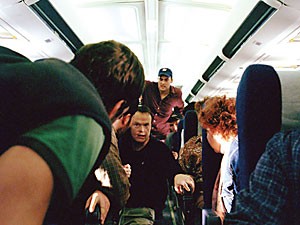The story of “”United 93″” is one that we’re all familiar with. On Sept. 11, 2001, terrorists boarded flights in the United States, hijacked the planes and crashed them into landmark buildings.
Flight United 93 was a plane heading out of Newark that was supposed to go to San Francisco. Instead, the terrorists took over the plane and planned to crash it into the Capitol Building.
Lowdown
“”United 93″”
R
111min.
Universal Pictures
6/10
The passengers on the flight banded together and realized that even though their fate was already out of their hands, they could keep others from suffering; they crashed the plane down in a remote area of Pennsylvania.
We already know what’s going to happen at the end of the film. The small gestures and interactions between the people take on a heightened importance because of this. We understand why the terrorist slips a knife into his pocket or hugs the others for longer than normal the night before.
The small talk before the hijacking stands out to the audience. There’s a hope that the passengers will talk about something more important or tell their parents on the phone that they love them. Instead, they talk about banal things like where the sugars are going to be kept on the plane.
“”United 93″” works well as a thriller because there’s always a sense of “”what if”” running through our minds because we have the advantage of hindsight. What if the airport security had stopped the four terrorists from getting through the gate? What if the air traffic control had picked up on the hijacking plots quicker? The sense of suspense is similar to what it feels like to watch “”Scream,”” where the audience is just waiting for the killer to jump out from behind the corner. Here, when one man barely manages to make it on time for flight United 93, we want to yell at him not to get on the plane.
Paul Greengrass (director of action thrillers like “”The Bourne Supremacy”” and “”Bloody Sunday””) keeps it as realistic as possible by taking an almost documentary-style handling. Rather than the polished Hollywood style we’re used to, the camera work is frantic, following the running passengers or hurried workers at the air control center. People walk in front of the camera like it’s not even there, covering the shot. The shakiness and graininess makes it seem like a home video.
That’s what this movie is for us – a home video that we’re watching of memories from a time not too long ago. The lack of commentary or taking any sort of stance on the events that transpire makes it nothing more than a re-enactment. There is nothing here we couldn’t get from watching CNN or catching a documentary on the History Channel. When the plane crashes at the end of the movie, the screen just goes black. There’s nothing to it – no motivating political speeches or look at what was the motivation behind these acts. That’s why people might be so against this film, not because they’re not ready to see it again, but because Greengrass adds nothing new to our understanding of that day.
There must have been some reason for putting this film out now, but it doesn’t come across at all in watching it. With the political division in the country, maybe the producers felt that there was a built-in audience. Unfortunately, controversy creates dollars, and maybe that’s why filmmakers felt that now was the right time to relive Sept. 11. But more time would have added more understanding to the events and allowed viewers to take something more away from a film like “”United 93.””









